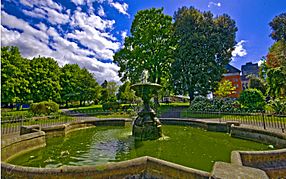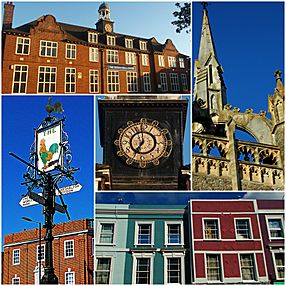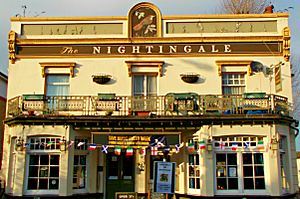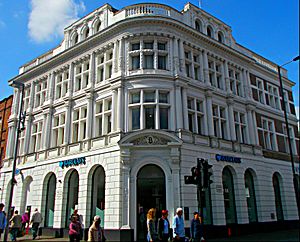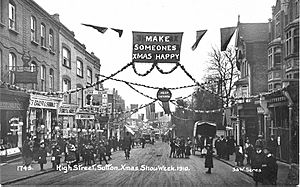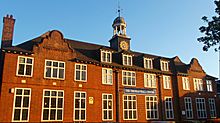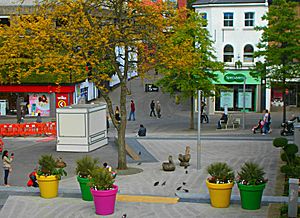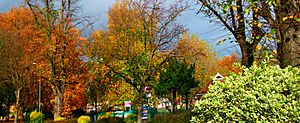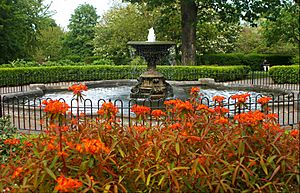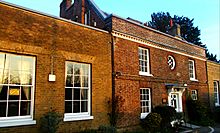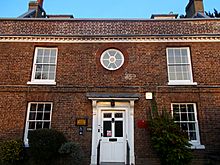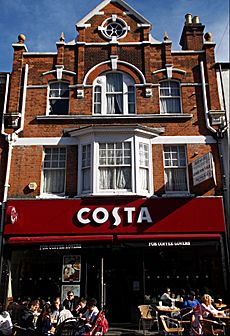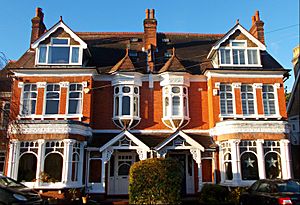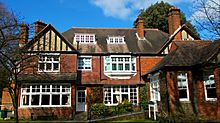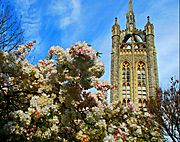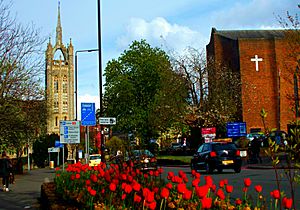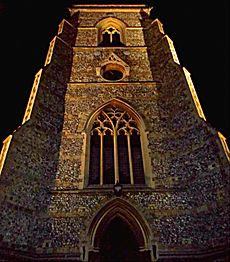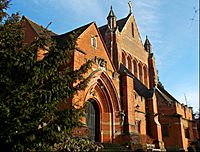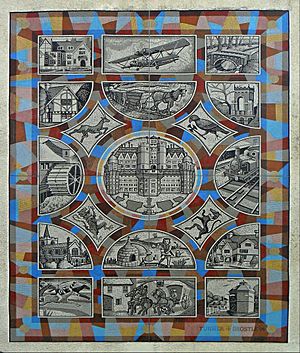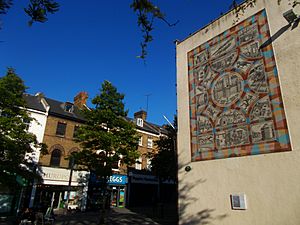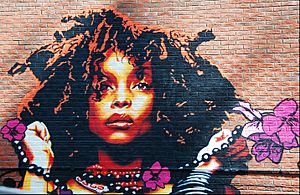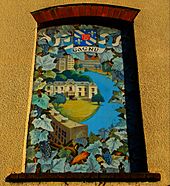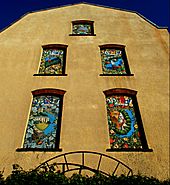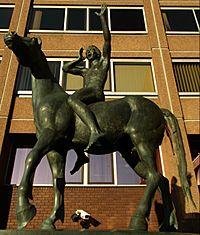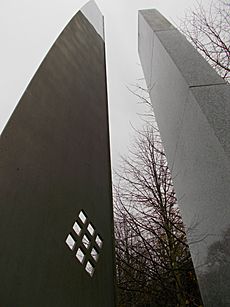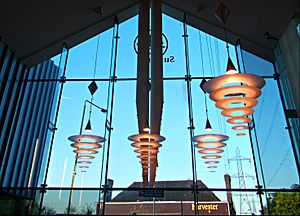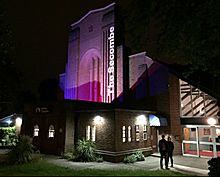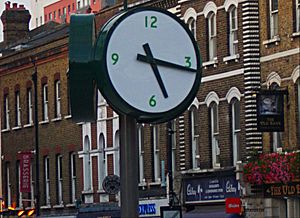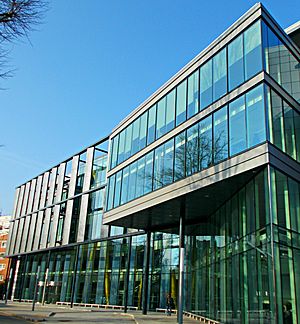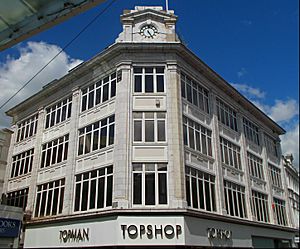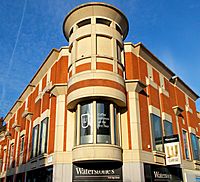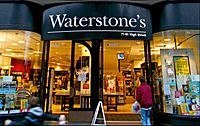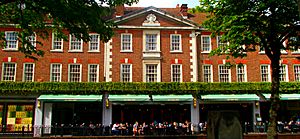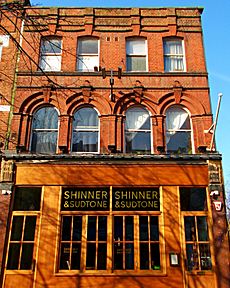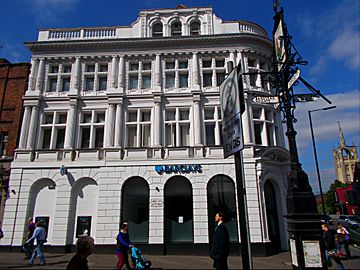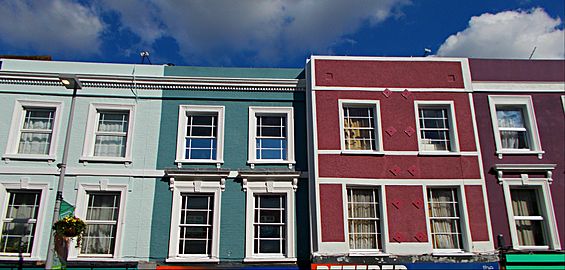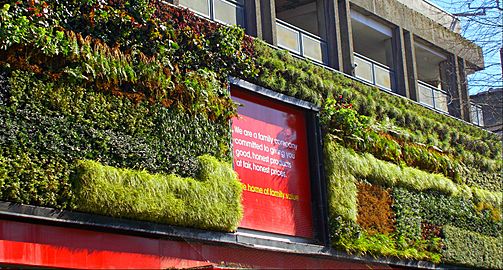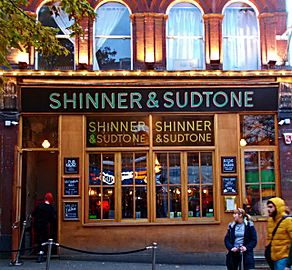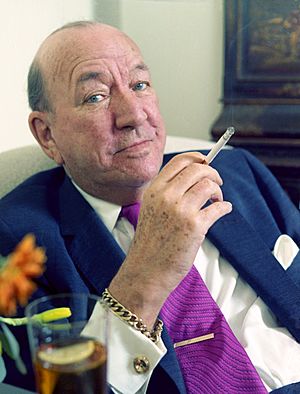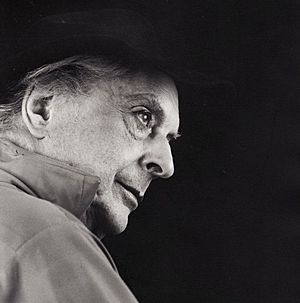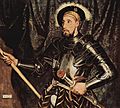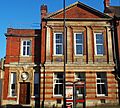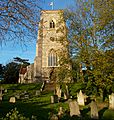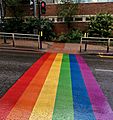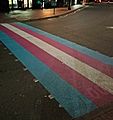Sutton, London facts for kids
Quick facts for kids Sutton |
|
|---|---|
|
From top, left to right: Manor Park fountain; Thomas Wall Centre and clock; Trinity Church spire; old inn sign above town centre crossroads; multicoloured facades in Sutton High Street
|
|
| Population | 41,483 (2011) |
| OS grid reference | TQ255645 |
| • Charing Cross | 10 mi (16 km) NNE |
| London borough | |
| Ceremonial county | Greater London |
| Region | |
| Country | England |
| Sovereign state | United Kingdom |
| Post town | SUTTON |
| Postcode district | SM1–SM3 |
| Dialling code | 020 |
| Police | Metropolitan |
| Fire | London |
| Ambulance | London |
| EU Parliament | London |
| UK Parliament |
|
| London Assembly |
|
Sutton is a main town in South London, England. It is the administrative center for the London Borough of Sutton. The town is located on the lower slopes of the North Downs. It is about 10 miles (16 km) south-south west of Charing Cross in central London. Sutton is one of London's thirteen major metropolitan centers. In 2011, the town had a population of 41,483 people. The entire borough had 204,525 residents.
Sutton was originally an old parish in Surrey. It is mentioned in the Domesday Book from 1086. Back then, it had two churches and about 30 houses. In 1755, a main road from London to Brighton was built through Sutton. This led to the opening of inns and helped the village grow. When the railway connected Sutton to central London in 1847, it started to become a town. It grew even more in the 20th century. In 1934, it became a borough with Cheam. In 1965, it became part of Greater London.
Sutton has the largest library in its borough. It also has many public art displays and four special conservation areas. The town is home to large international companies. It has London's sixth most important shopping area, mainly on Sutton High Street. Sutton railway station is the biggest in the borough. It offers frequent trains to central London and other places like Horsham. Sutton is also a popular place for filming movies and TV shows in South London. It is home to the Royal Marsden Hospital and the Institute of Cancer Research. There are plans to create the world's second largest cancer research campus here.
Sutton borough has some of the lowest crime rates in London. It is also one of the best performing education authorities in the country. In 2011, it was the top borough in England for GCSE exam results.
Contents
History of Sutton
Where the Name Comes From
The name Sutton is found in the 1086 Domesday Book as Sudtone. It comes from old English words meaning 'the south farm'. It was likely called "south" in relation to nearby Mitcham and Morden. The name was later used for Sutton Common and the new town area built in the 1800s.
Sutton Before the 1700s
Archaeologists have found things in the area that are over ten thousand years old. The first clear signs of people living here come from a Roman villa found in Beddington. A tool from the Stone Age was found near Sutton High Street. The old Roman road called Stane Street forms part of Sutton's northern boundary. Today, modern roads like Stonecot Hill and London Road follow its path.
Sutton was first recorded as Sudtone in a charter from Chertsey Abbey. This document is thought to be from the late 600s. It says that the Manor of Sutton was given to the Abbot of Chertsey. Other places mentioned in this charter include Beddington, Cheam, and Carshalton.
In William The Conqueror's Domesday Book of 1086, Sudtone was described. It had two churches, about 30 houses, and a population of around 200 people. The book also states that the Abbot of Chertsey owned the Manor. In 1145, the Prior of Merton had vineyards in Sutton.
In 1538, the Manor was sold to King Henry VIII. He then gave it to Sir Nicholas Carew. When Sir Nicholas was sentenced to death, the King took the manor back. Later, Queen Mary gave it back to Sir Nicholas Carew's son, Francis. The Manor became Crown property again until King Charles II gave it to the Duke of Portland in 1663. It has changed hands many times since then.
Sutton from 1700 to 1900
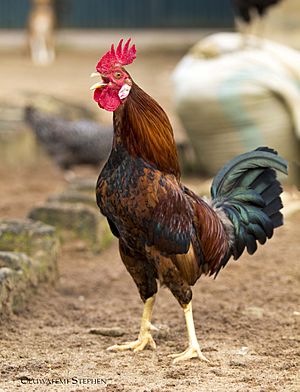
In 1755, a turnpike road was built from London to Brighton. This road met another turnpike from Carshalton to Ewell in Sutton. Toll booths for these roads were first located near the Cock Hotel. This was a coaching inn at the crossroads of the turnpikes. The inn's sign stretched over the Brighton road. Its owner was a famous boxer named "Gentleman" Jackson. The inn was named "Cock" because of the extra horses (cock horses) needed for coaches on this part of the road. About twenty horse and carts used this road daily.
The London to Brighton stagecoach service started in 1760. The Cock Hotel was the 9 a.m. breakfast stop for coaches leaving London. This regular contact helped Sutton grow and become more sophisticated. Small businesses opened, first serving travelers, then trading with nearby communities. Over time, the toll booths moved further away as Sutton expanded. The toll booths remained until 1882.
Sutton railway station opened on May 10, 1847. With this new, fast link to central London, Sutton's population more than doubled between 1851 and 1861. The village quickly grew into a town. New homes were built in the Lind Road area, called the "New Town." A pub built in 1854 was named the Jenny Lind. It was named after a famous Swedish opera singer who visited the area. It is now called the Nightingale.
The Sutton Water Company started in 1863. This allowed houses to be built in new areas that now had clean water. The population of Sutton more than doubled again between 1861 and 1871. This growth was helped by the development of the upscale Benhilton area to the north.
The 1870-1872 Imperial Gazetteer of England and Wales described Sutton as a village and parish in Surrey. It noted that Sutton had a post office, a railway station, and two hotels.
The upper part of the High Street was known as Cock Hill until the 1880s. The shops on the east side were built in 1880, ten years after those on the west side. A notable building from this time is the grand London and Provincial Bank building (now Barclays Bank). It was built in 1894 overlooking the historic crossroads. This four-story building is a prominent landmark.
In 1884, Sutton High School for Girls was founded. In 1899, Sutton County Grammar School (now Sutton Grammar School for Boys) opened with just nineteen students.
In 1897, Sutton Masonic Hall was built in Grove Road by local freemasons. Freemasons have met there since it opened, except for two years during World War II when the military used the hall. The building was designed by Richard Creed and built by Duncan Stuart & Sons.
A new Cock Hotel was built in 1896-1898 next to the original one, which was then torn down.
Sutton in the 20th Century
By 1901, Sutton's population reached 17,223. More housing was built for workers and the middle class. By the early 1900s, the High Street was heavily developed.
In 1902, the Banstead Road site of the South Metropolitan Industrial School was bought. This site later became the Downs Schools and then the Downs Hospital. Today, it is shared by the Royal Marsden and Sutton Hospitals and the Institute of Cancer Research.
Sutton's main post office moved to new premises next to the Masonic Hall on Grove Road in 1907.
The Sutton Adult School and Institute opened in 1910 in a large Edwardian building. It later became the Thomas Wall Centre, named after Thomas Wall. He was famous for Wall's sausage and ice cream. Thomas Wall wanted to encourage learning in others, so he set up a trust. The first part of the building opened in 1910, and an extension opened in 1911. The adult school was said to have the best facilities in the UK. By 1915, it had clubs, libraries, legal advice, and classes. It also had what was claimed to be the best gymnasium in southern England, outside of prisons.
In 1934, Sutton Baptist Church opened in the town center.
During World War II, bombing was not as heavy as in central London. However, 187 civilians in Sutton and Cheam died. Between 1940 and 1944, 434 bombs were dropped on Sutton and Cheam. A local "bomb map" was made after the war to record each bomb.
In 1950, the Cock Hotel was torn down to widen the High Street. It was not rebuilt. However, its old inn sign still stands, overlooking the historic town-center crossroads. Another former pub, the Greyhound, had a sign over the High Street in 1932. The pub's name lives on in Greyhound Road.
In 1959, a local resident, George Edgar Alcock, started a campaign to save a unique avenue of copper beech trees. This led to the formation of the Sutton and Cheam Society, a local group that still exists today. A plaque honoring Mr. Alcock is located at the junction of Christchurch Park and Brighton Road.
Population and People
| 1881 | 10,334 |
|---|---|
| 1891 | 13,977 |
| 1901 | 17,223 |
| 1911 | 21,270 |
| 1921 | 21,063 |
| 1931 | 27,989 |
| Absorbed by Sutton and Cheam parish ► |
|
| source: UK census | |
Most of Sutton, including the town center, is in the SM1 postcode area. Areas south of Sutton railway station are in SM2, and the western part of Sutton Common is in SM3.
In the 2011 census, the town's population was 41,483. This includes the Sutton Central, Sutton West, Sutton North, and Sutton South areas. Most of the town's population belongs to the middle class ABC1 social group.
Geography of Sutton
Land and Elevation
Sutton is built on a narrow layer of Thanet Sands. This layer stretches from Croydon in the east to Epsom in the west. To the south, there is chalk from the North Downs. To the north, there is clay. The Thanet sands allowed for clean water wells, which attracted early settlements. The Sutton and Cheam Water Company started in 1863. It joined with the East Surrey Water Company in the 1990s to form Sutton and East Surrey Water.

Elevations in Sutton vary. They range from 115 meters (377 ft) above sea level in the south of Belmont to as low as 23 meters (75 ft) in the Sutton Common area. Sutton generally lies around 50 meters (164 ft) above sea level.
Location of Sutton
Sutton has been part of Greater London since 1965. However, "Sutton, Surrey" is often still used for addresses. This can be confusing because there is another, much smaller, Sutton in Surrey about five miles south-west of Dorking. Sutton mainline railway station is known as "Sutton (Surrey)" by Southern Railway Ltd.
Green Spaces in Sutton
Besides the St Nicholas church grounds, Sutton has two larger green areas in its town center:
Sutton Green is at the northern end of Sutton High Street. It is near All Saints Church. The green dates back to 1810. Victoria Gardens, a smaller green space, is across the road from Sutton Green.
Just north of Sutton Green are larger green spaces: Rose Hill Park East and Rose Hill Park West. Rose Hill Park East contains Greenshaw Woods, which gives Greenshaw High School its name.
Manor Park is located across from the police station. The park opened in 1914, and its fountain was added in 1924-25. A plaque says the fountain was given to the town by Councillor Chas Yates. Manor Park is also home to the Sutton War Memorial. The memorial was unveiled in June 1921. It honors 524 men who died in the First World War. There are also four angels on the memorial's base.
The current Manor Park Café opened in October 2010. This eco-friendly café uses straw-bale construction. This type of building can last for over 200 years. It was London’s first energy-efficient building to use this method.
In the south of Sutton, Banstead Downs begins. It stretches for about a mile south towards Banstead. Banstead Downs is a large Site of Special Scientific Interest, covering 430 acres (174 hectares).
- Local Nature Reserves
Sutton has two Local Nature Reserves:
- The Anton Crescent Wetland reserve has ponds, willow carr, and reedbeds. The ponds never dry out. They provide a home for birds like the green sandpiper and common snipe.
- Devonshire Avenue Nature Area is important for nature conservation. It has neutral grassland, chalk grassland, scrub, and trees. A special species found here is the small blue butterfly.
 |
Sutton Common, Lower Morden | Rosehill, St. Helier, Morden | Benhilton |  |
| North Cheam, Worcester Park | Carshalton | |||
| Cheam | Belmont, Banstead | Carshalton Beeches, Wallington |
Architecture in Sutton
Sutton's growth was largely due to the railways in the mid-1800s. So, most of the town's older buildings are Victorian. However, a few buildings are even older. The Georgian Sutton Lodge on Brighton Road is thought to be the oldest building still standing in Sutton. It was once the farmhouse of Sutton Farm. The land around it was sold for building houses, but the Lodge survived. It is now a day center for older people. The building is Grade II listed.
The High Street and central housing areas mostly feature Victorian architecture. Edwardian architecture is also common, especially among homes. The Victorian residential area east of the High Street, known as Newtown, is architecturally interesting because of its varied styles. Many different builders worked there, not just one.
Sutton also has buildings from more recent times, like the 1930s. Some show art deco and moderne styles, such as the brick Baptist Church designed in 1935. Modern buildings from the 21st century include the Aspects of Sutton and Lamborne apartment buildings, and the new police station extension.
Aspects was an old office building that was changed into apartments. It was given a new terracotta color and three extra floors for penthouses. With eighteen floors, it can be seen from far away. The Lamborne building is newer and built in a Docklands style. It is white with wooden parts and has balconies.
In 2003, the extension to Sutton Police Station was finished. It was opened the next year by Commissioner Sir John Stevens. This extension is much larger than the original Edwardian building. It is used by Sutton CID and other police units.
Conservation Areas
There are four special Conservation Areas in Sutton town itself. These are places where the historic character is protected. One is in the town center, and the other three are residential areas: Grove Avenue, Landseer Road, and the Sutton Garden Suburb.
Russettings House
Russettings is a large house built in 1899. It was one of the last big, upper middle-class houses built in the late 1800s in this area. It was first lived in by George Smith and his wife Mary. Mary was the sister of local helper Thomas Wall. The house was designed by Frederick Wheeler in an Arts and Crafts style.
The house has gabled roofs, large chimneys, bay windows, a green copper dome, and a porch with a tiled roof. In 1965, when the London Borough of Sutton was formed, the house became the Sutton Register Office. It was updated in 1994 to handle births, marriages, and deaths, and to host weddings.
Places of Worship
Three main churches are in Sutton town center: Trinity Church, Sutton Baptist Church, and St. Nicholas Church. Trinity Church and St Nicholas Church are across from each other on a street parallel to the High Street. The Baptist Church is nearby on Cheam Road. The Salvation Army has a center in Benhill Avenue.
Other churches near the town include All Saints Church (north), St Barnabas (east), and Christ Church (south), all Anglican. There are also two Roman Catholic churches: Our Lady of the Rosary (east) and the Church of the Holy Family on Sutton Green.
Sutton Synagogue is on Cedar Road, just south of the town center.
Trinity United Reformed and Methodist Church
The Grade II listed Trinity Church has a traditional style with an exterior made of Kent ragstone. Its "crown and lantern" spire is very unusual. Only two cathedrals, St Giles' Cathedral and Newcastle Cathedral, share this feature. The current building opened on October 2, 1907. It was renamed Trinity Methodist Church in 1932. In 1972, the Congregational and Methodist churches in Sutton joined together. Trinity became a joint United Reformed and Methodist church.
Sutton Baptist Church
The Baptist Church is quite modern compared to the other two town center churches. It was designed by architect Nugent Cachemaille-Day in 1935. It uses traditional materials like brick and tile, in a style influenced by the Arts and Crafts Movement. The church was built quickly, starting in January 1934 and opening in September of the same year. Its unique design attracted attention across the country.
The church is a good example of a modern brick building in Sutton. Its design has long walls and curved shapes in the moderne style. The windows are simple and clean, in a simplified Gothic style. Inside, there is a lot of exposed brickwork and sweeping pointed arches. Its simple design fits with the ideas of the Arts and Crafts Movement and modern architecture.
St Nicholas Church
The Grade II listed St Nicholas Church is the oldest of the three town center churches. It is surrounded by a small, old graveyard with trees. Many important historical residents of Sutton are buried in the churchyard. These include Mr Horward Orme, the last owner of the manor house. Also, 185 orphans from the Metropolitan District School are buried here. Their graves are marked by a memorial put up by the church's Sunday school children in 1921. A large World War II bomb landed on the churchyard in September 1940. It destroyed several graves, but the church building itself was not damaged.
All Saints Church
Just north of Sutton town center is All Saints Church, Benhilton. Its large size and location make it a local landmark. Its parish was created in 1863. The foundation stone of the Grade II* listed building was laid that same year. It was designed by Samuel Sanders Teulon in the Gothic Revival style. English Heritage calls the church "a very fine building." Thomas Alcock, who owned the manor, gave £18,000 and the land for the church, vicarage, and a school. The church was built for an estate of upper-class Victorian homes that Alcock was developing.
St. Barnabas Church
East of the town center is St Barnabas Church. It was built between 1882 and 1884 by architects R H Carpenter and Benjamin Ingelow. Its purpose was to serve the Newtown area of Sutton, which grew in the late 1800s. It is a red brick building with stone decorations, in the Gothic Revival style.
Christ Church
South of the town center, in Christchurch Park, is Christ Church, Sutton. It was built in 1888 for £8,000. It was located among the lavender fields east of Brighton Road at the time. More parts were added around 1910 to 1912. The church has the largest auditorium in Sutton.
Church of Our Lady of the Rosary and Church of the Holy Family
East of the town center is the Church of Our Lady of the Rosary. It was built in 1892. Plans to make the church bigger happened in 1912. In 1932, the church's current altar was blessed. The Church of the Holy Family, though closer to the town center, is newer. It started as Holy Family Church Hall in the 1960s. The current church was built in 1988.
Culture in Sutton
Sutton has many public art pieces, a large library, a music venue, a cinema, and a theater. It is also a popular place for filming in south-west London.
Imagine Festival of Arts
The annual Imagine festival of arts started in 2006. It has received funding from Arts Council England. Artists like John Hegley have been featured.
Public Art in Sutton
The town center has six examples of public art.
Three of these are large artworks on the sides of buildings.
Sutton Heritage Mosaic
There is a large town center mosaic that is 9 meters (30 ft) high and 5 meters (16 ft) wide. It covers an entire three-story wall near the Waterstone's bookshop. It is one of the largest wall art pieces in Britain. The London Borough of Sutton asked for it to celebrate the borough's history. Created by Drostle and Turner, the mosaic was made from small glass and clay tiles. It was put in place in 1994.
Rob Turner designed it. It shows different parts of Sutton's history in a classic geometric pattern. There are nineteen black and white panels on a colorful background. The main part shows Henry VIII's palace at Nonsuch. Other panels show symbols from old local families, as well as industrial and architectural history.
A plaque explaining the panels was put up in 2011. Councillor Graham Tope unveiled it. He said the mosaic has been a loved part of the High Street for 17 years. He hoped the plaque would help people understand and appreciate it more.
Wellesley Road Mural
There is another large wall art piece in Wellesley Road. It is about 100 yards south of the main railway station. The street artist Eva Mena from Spain created it. The mural is from 2008 and took three days to complete.
It was specially asked for by the owner of a cleaning company. It shows Erykah Badu, an American singer-songwriter. Her head, face, and shoulders are shown, with beads and many bracelets. Pink and purple flower petals complete the image. The painting covers the entire side wall of Indepth House, a small office building.
Sutton Twin Towns Mural
The twin towns mural is a set of seven paintings on one side wall. They show scenes from Sutton and its four twin towns in Europe. These are Gagny (near Paris), Gladsaxe (in Denmark), Minden (in Germany), and Charlottenburg-Wilmersdorf (in Berlin). The paintings are set inside seven fake window frames. They are located at the southern end of the High Street, near the train station.
Artists Gary Drostle and Rob Turner designed and painted the murals on plywood. They were unveiled in 1993 to celebrate 25 years of Sutton being twinned with Wilmersdorf. Each twin town is shown with its shield and images of its main features. Each also has a plant to show its care for the environment. For Sutton, this is a beech tree, which is where Carshalton Beeches gets its name.
Sculptures
Sutton Armillary
Besides the wall art, there is a Millennium Dial armillary. The Rotary Club gave it to the town in the year 2000. It is a historical timepiece with three purposes: to tell time, to remember time with inscriptions like the Rotary motto "Service Above Self," and to honor the work of the Rotary Club.
The Sutton armillary is a popular feature in the town center. It was first placed in a small "Millennium Garden." In 2011, it was moved slightly to the edge of the new central square, in front of a bookshop.
Since 1981, two outdoor sculptures have been added.
The Messenger
First, The Messenger statue, made of bronze by David Wynne, OBE in 1981. It shows a large horse and rider. The horse looks towards the railway station. The rider, sitting bareback, raises his left hand and his right hand to his mouth, as if calling. It is life-size and stands on a 7-foot (2.1 m) marble and granite base. The total height is 150 inches (3.8 m).
The statue was asked for by Business Press International Ltd. Now, Reed Business Information is responsible for its upkeep. It was a big project for the sculptor, taking four years to complete. The sculpture is located right outside Quadrant House, next to Sutton railway station.
Transpose 2002
Second, the Transpose 2002 sculpture by Michael Dan Archer. It is at the junction of Carshalton Road and Langley Park Road. It is 7 meters (23 ft) tall, 1.5 meters (5 ft) wide, and 1.5 meters (5 ft) deep. It is made of Chinese granite and stainless steel. It has a steel blade-like shape next to a granite form. The blade has a grid that lets the sun shine through onto the granite.
It was commissioned by Chartwell Land, B&Q, and the London Borough of Sutton. It was created in 2002. Archer says his sculptures show the "massiveness and physicality of stone." The design, location, and size of Transpose 2002 make it an important landmark for people entering Sutton town center from the east.
Literary Facilities
Sutton Library is near the top of the town, close to St Nicholas Church and the Holiday Inn Hotel. It is part of a complex that includes the Civic Offices, home of Sutton Borough Council, and the Sutton College of Liberal Arts. It is the largest library in the borough. It opened in 1975 and was updated in 2004. It was the first public library to have a writer-in-residence. It was also the first to lend CDs and videos, and the first to offer full public library service on Sundays. The library has four floors with lending and reference areas, a lounge, a café, IT facilities, music listening areas, and a children's library.
Art exhibitions are held in the library's Europa Gallery.
Sutton Life Centre
The Sutton Life Centre is an £8 million facility. It is designed to help young people and encourage good citizenship. The center opened on October 27, 2010, by the then Deputy Prime Minister Nick Clegg.
The center's main feature is The Lifezone. This is a virtual street with giant projection screens on all walls. It uses film-set technology to create an "immersive learning environment." Students are shown real-life scenes from Sutton's streets. This teaches them about citizenship, personal safety, and the environment.
Theatre and Cinema
- Theatre
The Secombe Theatre (named after Sir Harry Secombe) was on Cheam Road. Sir Harry, who lived in Sutton for over 30 years, opened the theater. It was created in 1984 from a former Christian Science church building. The theater was run with the Charles Cryer Studio Theatre in Carshalton. In 2016, the theater closed permanently.
- Cinema
The former Granada Cinema, designed by Robert Cromie, opened in 1934 as the Plaza Theatre. It showed films like Catherine the Great. While built as a cinema, it also had a stage and dressing rooms for pantomimes. Like many old cinemas, it was torn down in 1975. The office building, Sutton Park House, now stands on its site.
About half a mile northwest of the former Granada, there is the six-screen Empire Cinema. It is across from the St. Nicholas Centre shopping center. It opened in 1991, at the same time as the center.
Media and Filming
Along with Wimbledon Studios, Sutton is a popular place for filming in south-west London.
The Return of Mr Bean was filmed at Allders. Episodes of The Bill were also filmed in Sutton.
The sitcom Phoneshop, which started in 2010, was filmed on Sutton High Street.
A local film director won an award at the IAC British International Amateur Film Festival in 2014.
Scenes for the Hollywood film Black Sea were shot outside Sutton Grammar School on August 1, 2013. Jude Law appeared in these scenes.
Music in Sutton
Sutton Symphony Orchestra was founded in 1946. They usually give three concerts each season. Most concerts take place in Sutton.
The Boom Boom Club in West Sutton hosts regular rock concerts. Often, classic rock bands like Focus play there.
Historical Note: The Rolling Stones
The Rolling Stones were discovered in 1963 at the Red Lion public house (now the Winning Post) in Sutton High Street. The band played several early concerts there. During one performance, music manager Giorgio Gomelsky saw them. He signed them for a residency at Richmond's Crawdaddy Club. This happened months before they became famous.
Charlie Watts and Bill Wyman also became permanent members of the band at the Red Lion Pub on January 23, 1963.
In 2011, the Winning Post was added to a list of important local buildings.
Transport in Sutton
Sutton station is the town's main station. Frequent direct trains run to central London stations like London Victoria, London Bridge, and St Pancras International. The station is served by both Thameslink and Southern trains.
The fastest trains to Victoria from Sutton take 25 minutes. There are also direct services to places outside central London. These include Dorking, Epsom, Horsham, and St Albans.
West Sutton and Sutton Common stations are on the Thameslink lines. They go to Wimbledon and then directly into central London.
Local bus services are run by several companies. There are also express coach services to Heathrow Airport and Gatwick Airport.
Road traffic is directed away from the mostly pedestrianized town center. Sutton has many designated cycle routes. There are three main car parks in the town center and a car club.
In 2014, there was a discussion about extending the Tramlink from Wimbledon to Sutton.
Economy of Sutton
Sutton is one of the eleven major metropolitan centers in the London Plan. The borough has very low crime rates compared to other parts of London. The town has a major shopping area, mainly on Sutton High Street.
Sutton has over 6,800 businesses. This is an increase of about 19% since 1994. In 2012, 863 new companies started in Sutton, the highest number ever recorded. Most of these were small or medium-sized. However, several large businesses are also present. For example, Reed Business Information, a media publishing company, has a large office building called Quadrant House next to the station. It is a major local employer.
G4S has offices in the large Sutton Park House building. Crown Agents Bank, which provides foreign exchange services, is headquartered in Quadrant House. Another important local business is subsea engineering company Subsea 7.
A town center manager works with local businesses, police, and transport providers. Their job is to promote the center and its economic growth. "Opportunity Sutton" and Sutton Chamber of Commerce also help the local economy.
Town Center Improvements
Several major building projects have recently finished or are being built in the town center:
Sutton Point, at the southern end of the town center, will include a hotel, apartments, a health club, shops, and offices. Construction of this £90 million project was expected to finish in December 2018.
The Old Gas Works, a large development at the north end of the High Street, was completed in 2016. It includes apartments, a Sainsbury's supermarket, shops, and a landscaped square with a fountain. This project was a £50 million investment in the town.
Subsea 7 has expanded in Sutton, making it the site of its new world headquarters. The company moved to a new, purpose-built, five-story office building. This created 400 new jobs, bringing the total workforce in Sutton to 780. Construction started in 2014 and finished in late 2016.
In September 2015, the council hired a design team to create plans for the town's central area for the next 15 years. The plans include new housing and commercial spaces, a possible new primary school, and better transport links. They also plan to keep the "high-quality Victorian, Edwardian and Mock Tudor buildings."
In June 2016, the council published a plan called "Sutton 2031: Planning for our Future." It includes new developments, better public spaces, and transport improvements. This plan will include:
- "Immediate High Street projects"
- "Transforming the St Nicholas Centre"
- "Creating a new south London destination with culture, leisure and restaurant activity"
- "Redeveloping the Civic Centre"
Heritage Action Zone
In March 2017, Sutton town center was named one of the first ten Heritage Action Zones by Historic England. This status will provide resources to improve the historic environment. It will help keep the town's unique architectural style while encouraging economic growth.
Shopping in Sutton
- Shopping History
Shopping has been a big part of Sutton's economy since the Victorian era. The oldest shop still open in Sutton is Pearson Cycles. It started in the 1860s as a blacksmith shop. In the 1890s, it changed to making and repairing bicycles. The Pearsons have run the bike business from the same High Street location ever since. It is recognized by Guinness World Records as the oldest bicycle shop in the world.
- Shopping Environment
Sutton is London's sixth most important shopping center. It attracts shoppers from a wide area. Sutton High Street is almost a mile long. It has many of the country's main high street stores.
Sutton is often chosen for new shops. For example, the Sutton branch of the Waterstones bookshop chain was the first to have a café.
- Shopping Centers
There are two covered shopping centers in the middle of the shopping area. The larger one is the St. Nicholas Centre, with three levels. Times Square is smaller. It opened in 1985 and was relaunched in 2017 after being updated.
- Restaurants and Bars
Sutton has many restaurants, bakeries, coffee shops, gastropubs, and bars. It even has the country's first branch of All Bar One. The central area is for pedestrians, which allows for outdoor seating.
Sutton's restaurants have grown in recent years. Now you can find French, Lebanese, British, vegan, Malaysian, Thai, Pakistani, Portuguese, Turkish, Sri Lankan, and Japanese food. There are also older Italian, Indian, and Chinese places. One French restaurant was listed in the 2013 Good Food Guide and was Michelin-listed.
- Pop-up Market
A "pop-up" market is held every month at the northern end of Sutton High Street. It helps local people start their own businesses. Products for sale include natural cosmetics, jewelry, and handmade clothing.
- Street Performance
The high street and town square host street performances. These include music, art, and theater. Markets are held sometimes, including French, Italian, and Continental markets. There are also arts and crafts fairs.
In August and September, the high street hosts the outdoor "Sunset Cinema." Films are shown in the evening to people sitting in deckchairs. This is the only event of its kind in London. It aims to encourage people to use local restaurants and bars. The High Street has also hosted a country music festival for the last two summers. A temporary mini-golf course is set up in August.
- Green Wall
There is a green wall or "vertical garden" in the shopping area. It is designed to look nice and to improve air quality and biodiversity. It helps birds and insects find places to live and nest. It also helps reduce carbon footprint and smog from traffic. The green wall covers the front of a large High Street store and is in bloom all year.
Sport in Sutton
Sutton United F.C. plays in the EFL League Two. This is the 4th level of English football. They reached this level for the first time in their 123-year history after winning the 2020-21 National League. They are nicknamed The U's. They famously beat Coventry City in the FA Cup in 1989. In 2016–17, they reached the 5th Round of the FA Cup for the first time. Sutton United's home ground is Gander Green Lane.
Sutton Common Rovers F.C. plays in the Combined Counties Football League Premier Division.
Sutton Cricket Club is on Cheam Road. The club's top team plays in the Surrey Championship Premier Division, which they won in 2009.
Education in Sutton
Schools in Sutton
Sutton is the main town in the London Borough of Sutton. This borough is known for its high-performing schools. The town has many of the borough's schools. These include one of its boys' grammar schools, its boys' preparatory school, and its girls' private secondary school.
Primary schools
|
|
Secondary schools
|
|
In 2013, Sutton's GCSE exam results were second best among all boroughs in England. In 2011, Sutton was the top-performing borough in England. You can find more information on school performance in the London Borough of Sutton article.
Adult Education
The main center of Sutton College is in Sutton. It was first called Sutton College of Liberal Arts. The college offers over 1000 part-time courses at its centers across the borough.
Notable People from Sutton
This list includes people specifically linked to the town of Sutton. For a full list from the wider borough, see London Borough of Sutton.
- Martin Adams, professional darts player, was born in Sutton.
- Joan Armatrading, singer-songwriter, lived in Sutton in the 1970s.
- Ben Barnes, actor, went to Homefield Preparatory School.
- David Bellamy, broadcaster and botanist, went to Sutton Grammar School.
- Johnny Borrell, guitarist and singer for the band Razorlight.
- Noël Coward, actor and playwright, lived in Lenham Road, Sutton when he was young.
- Quentin Crisp, writer and speaker, was born in Sutton.
- Clark Datchler, lead singer of Johnny Hates Jazz.
- Jack Draper, professional tennis player, born in Sutton.
- Catherine Holman, actress, born in Sutton.
- Jon Hiseman, drummer for the band Colosseum, was born in Sutton.
- James Hunt, racing driver and 1976 Formula One World Champion, lived in Sutton as a child.
- Penelope Keith, actress, known for The Good Life, was born in Sutton.
- Ruth Kelly, former Labour Party politician, went to Sutton High School.
- Rebecca Litchfield, photographer, was born in Sutton.
- Bradley McIntosh, member of the band S Club 7, went to Greenshaw High School.
- Katie Melua, award-winning singer, lived in Gander Green Lane, Sutton.
- Phyllis Mudford King, Wimbledon ladies doubles winner 1931, went to Sutton High School.
- Brian Paddick, Baron Paddick, politician, went to Sutton Grammar School for Boys.
- Peter Penfold, diplomat, went to Sutton Grammar School.
- Sidney Richard Percy, painter, lived in Mulgrave Road, Sutton.
- Frank Potter, artist and art teacher, was born in Sutton in 1896.
- Michael Reeves, film director, known for Witchfinder General.
- Dora Russell, author and feminist, went to Sutton High School.
- Sir Harry Secombe, comedian and singer, lived in Sutton. The Secombe Theatre is named after him.
- Ian Stewart, co-founder of The Rolling Stones.
- Graham Sutherland, painter, went to Homefield Preparatory School, Sutton.
- Baron Tope of Sutton, politician.
- Helen Young, BBC Weather Presenter, lives here.
- Zacron, designer of the Led Zeppelin III album cover.
Images for kids


